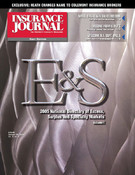While it did not begin boiling over until last October when charges were brought against Marsh, the controversy over brokerage contingent fees has actually been simmering for more than a half dozen years in New York insurance circles.
Back in 1998, the New York State Insurance Department ordered brokers and insurers to disclose to policyholders all compensation agreements between brokers and insurers and to keep a record of these fees. The regulatory order, known as Circular Letter No. 22, even warned that the department would inquire about these agreements in future market conduct exams.
The letter states that a broker is a legal representative of the insured, and that the undisclosed receipt of additional compensation from an insurer is sufficient to create the perception that brokers are conflicted in their loyalties. It says that such conduct may constitute a violation of state insurance law and raise issues of trustworthiness.
Circular Letter No. 22 was a pioneering effort by then Superintendent of Insurance Neil Levin and it was met with opposition at the time and for years thereafter from brokers who argued that it exceeded his authority.
Today that regulatory letter has resurfaced as Exhibit A in the debate over the future of contingent commissions and, some would add, the future of state regulation.
Last October, New York Attorney General Eliot Spitzer charged that contingent fees paid by insurers to brokers under so-called market service or placement service agreements led to illegal activity, including bid rigging and account steering. Several of the largest insurance brokers have voluntarily discontinued MSAs and PSAs but others inside and outside the industry have been grappling with whether contingent fees should be outlawed or if simply requiring their disclosure is enough protection against conflicts of interest.
N.Y. Assembly committee hearing
The New York Assembly Committee on Insurance held its first public hearing on brokerage practices at the Alexander Hamilton Customs House in New York City on Jan. 7. Assemblyman Alexander “Pete” Grannis, chairman, used the hearing to grill officials on what should be done to protect insurance buyers from conflicts of interest arising from contingent fees.
Grannis suggested that the New York department had effectively given contingent fees its approval in 1998 with the circular letter. “The department saw no inherent conflict, right?” Grannis asked Superintendent of Insurance Gregory Serio, who testified in one of his last appearances as the state’s regulator. Serio stepped down on Jan. 18 for a job in the private sector.
“At the time, we did not see the improper behavior behind the contingent fees but the potential was there so the department absolved the conflict by requiring disclosure,” Serio acknowledged.
Grannis pressed Serio on what the department did after 1998 to enforce the policy set forth in the circular letter.
Serio told Grannis that the department held meetings to discuss the fees and monitored whether brokers had disclosure standards. But the department did not pursue the matter in market conduct exams, he acknowledged.
“Circular Letter No. 22 shows disclosure doesn’t work,” Grannis declared at one point, adding that a legislative ban on contingent fees may be needed.
While Grannis used the circular letter to question the effectiveness of the state’s regulation, Serio used it in his department’s defense, noting that no other state regulator had gone as far to draw attention to potential conflicts with contingent fees.
Serio described how involved the department was on the issue before Spitzer broke it open last Oct. 14. The department had commenced its own investigation after it received notification from American International Group in July 2002 “that there might not be adequate disclosure of broker compensation arrangements in the insurance marketplace.” That effort lagged, he said, in part because AIG never supplied the necessary specifics and declined to cooperate with an undercover sting operation.
Despite the stalled effort with AIG, the department continued its inquiry, asking carriers and brokers if they had PSAs or MSAs and how they were disclosed to insureds, according to Serio. The department collected more than 2,500 pages of information but never learned of illegal activity.
Everything changed in April 2004 when an unidentified insurance industry employee sent a specific tip, not to Serio’s department, but to Spitzer’s office, alleging illegal activity tied to the MSAs. Thereafter, the offices of Spitzer and Serio worked closely together with the AG’s office taking the lead to pursue possible criminal charges.
Spitzer acknowledgement
Even Spitzer acknowledged the importance of Circular Letter No. 22 before the committee.
“The insurance department properly identified trustworthiness as a primary concern arising from insurance brokers’ receipt of undisclosed compensation,” he said. “However, at the time, the direct connection between a broker’s receipt of undisclosed compensation and the widespread market manipulation, fraud and steering practices that result from such compensation, was not fully understood.”
Spitzer said that contingent fees have “infected practically every line of insurance business” and that while the public focus thus far has been on commercial insurance, “there are other private inquiries” into personal lines that “will come out in due course.”
Pressed by committee members as to what lawmakers should do, Spitzer said he is “still forming” his opinion on what, if any, legislation is needed. The AG said it is possible that stronger enforcement, rather than new laws, may be the correct response. “Time will tell,” he said.
But he weighed in on the adequacy of disclosure. “If we were to start with a blank slate I would intuitively say full disclosure would be the model but now I would say disclosure is not sufficient. The brokers have made that determination,” Spitzer told Grannis.
Agents’ disclosure policy
The Independent Insurance Agents & Brokers of New York Inc., meanwhile, has launched a campaign seeking to both defend profit sharing agreements of independent agents and urge brokers and agents to disclose all forms of compensation they receive. IIABNY’s “full disclosure” policy won praise from Grannis, who noted that it goes further than the national IIABA policy, and from Serio, who termed it a “step in the right direction.”
IIABNY Secretary-Treasurer Sharon Emek, Ph.D., told the committee that profit sharing arrangements earned by independent agents differ greatly from the PSAs and MSAs that are at the heart of the current investigations.
Unlike MSAs and PSAs, profit sharing agreements are earned over time, often over several years, and are not tied to any single account, she noted. PSAs and MSAs are available only to the largest brokers, such as Marsh and Aon, she added.
Topics Agencies Legislation New York
Was this article valuable?
Here are more articles you may enjoy.


 New York Governor Hochul Vows to Tackle Insurance Affordability, Litigation and Fraud
New York Governor Hochul Vows to Tackle Insurance Affordability, Litigation and Fraud  NYC Mayor Mamdani Widens Delivery-App Crackdown With Lost-Pay Lawsuit
NYC Mayor Mamdani Widens Delivery-App Crackdown With Lost-Pay Lawsuit  Trump Nominates WeatherTech’s MacNeil to Be FTC Commissioner
Trump Nominates WeatherTech’s MacNeil to Be FTC Commissioner  LA Fire Survivors Got a Rude Surprise That Could Hit More Americans
LA Fire Survivors Got a Rude Surprise That Could Hit More Americans 


